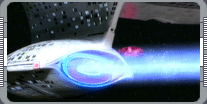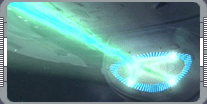
Navigational Deflector Array
Without its main deflector dish, starships would have been incable of traveling at high velocity.
 The primary function of the Navigation Deflector Array (NDA) was to clear a path ahead of the ship. It did
this by generating a deflector beam in front of the ship that pushed debris out of the way. Most recent
Starfleet vessels have been equipped with an auxiliary deflector dish. While the secondary deflector on
Intrepid-class or
Nova-class starships are more obvious, some like on the
Galaxy-class are built within the hull.
The primary function of the Navigation Deflector Array (NDA) was to clear a path ahead of the ship. It did
this by generating a deflector beam in front of the ship that pushed debris out of the way. Most recent
Starfleet vessels have been equipped with an auxiliary deflector dish. While the secondary deflector on
Intrepid-class or
Nova-class starships are more obvious, some like on the
Galaxy-class are built within the hull.
At warp, or even impulse speeds, anything, from micrometeoroid particles to asteroids, posed a major
navigational hazard. Even repeated collison with stray hydrogen atoms could cause damage to the ship. The
significance of the deflector system cannot be overstated; the NDA is an absolutely vital part of the ship.
The beam itself is a graviton beam that was focused and manipulated by a series of subspace field coils.
This powerful tractor/deflector emission sweeps thousands of kilometers ahead of the ship, pushing aside not
only small particles, but also larger objects that could present a hazard. The navigational sensors
detected any object that were too large to displace and made automatic course corrections. In addition to
the actual deflector beam, the dish generates a series of parabolic shields that extended approximately
two kilometers in front of the ship; these low-level fields were relatively static, and were designed to
deflect stray hydrogen atoms and any submicron particles that the main deflector beam may have missed. The
deflector system is powered by three redunant high-powered graviton polarity source generators. These fed
two 550-millicochrane subspace field distortion amplifiers, with the resulting energy being focused by the
subspace coils through the deflector array.
The array, which is made up of a series of molybdenum-duranium mesh panels, is mounted on a duranium
framework. The NDA, and therefore direction of the beam it emitted, could be steered by the navigational
computer system. Its movement was controlled by four high-torque electrofluidic servos, which could move
it as much as 7.2 degrees from the ship's X-axis. Because of the large amounts of power required by the
deflector beam, the system generates significant subspace and electromagnetic radiation. such fields
sometimes affect the ship's sensor systems.
 To avoid this potentially dangerous interference, the long-range sensor equipment is located directly behind
the main deflector dish. The emitters from the sensors and the deflectors were aligned in such a way that
both of their fields issued outward from virtually the same point, effectively allowing the sensors to look
straight through the interference generated by the deflector systems. A significant increase in power to
the deflectors could still affect some of the systems, notably the subspace field stress and gravimetric
distortion sensors, so the balance was carefully maintained unless there was an emergency. If an unusual
or dangerous situation occurred, the sensor dish could perform functions for which it was not specifically
designed. Various fields can be channeled with great effect through its broad aperture, and these could be
used as weapons or to remove anomalies.
To avoid this potentially dangerous interference, the long-range sensor equipment is located directly behind
the main deflector dish. The emitters from the sensors and the deflectors were aligned in such a way that
both of their fields issued outward from virtually the same point, effectively allowing the sensors to look
straight through the interference generated by the deflector systems. A significant increase in power to
the deflectors could still affect some of the systems, notably the subspace field stress and gravimetric
distortion sensors, so the balance was carefully maintained unless there was an emergency. If an unusual
or dangerous situation occurred, the sensor dish could perform functions for which it was not specifically
designed. Various fields can be channeled with great effect through its broad aperture, and these could be
used as weapons or to remove anomalies.
|
|
"BRIEFING: U.S.S. ENTERPRISE NCC-1701-D" - JANUARY 2001 ISSUE 21 STAR TREK: THE MAGAZINE COPYRIGHT 2005 OF
PARAMOUNT PICTURES.
|